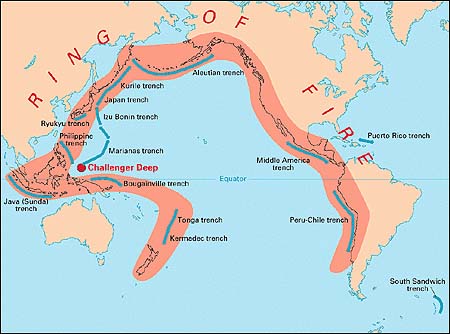
Ring of Fire. No, I am not writing about a carnival ride or the song by Johnny Cash. When I heard the name recently on television, that’s what I assumed they were discussing, but within moments, my friend and I were enthralled. Our conversation stopped as we learned about the 25,000 mile arch around the Pacific Ocean, which is home to most of the world’s seismic activity.
In simplified terms, the Ring of Fire is a collision zone for tectonic plates, which creates substantial seismic activity. As you may remember from 6th grade Earth Science, tectonic plates form the crust of the earth. Over 52 plates cover the earth, and where they unite, they can wreak havoc. Sometimes the collision is so forceful one plate is pushed on top of another, and a mountain is formed. When a column of lava pushes its way up inside of that mountain, a volcano is born. Other times, the two plates cause enough friction to shake the surrounding crust, a phenomena all of our west coast readers are surely familiar with.
As you can see on the above map, the entire west coast of the United States is located along the Ring of Fire. In this area, seismic activity primarily takes the form of earthquakes, although there are numerous volcanoes, both active and dormant, as well.
These same phenomena take place along the entire arch. Basically, the Ring of Fire is one huge collision zone around the Pacific Ocean basin. This collision zone carries some impressive stats, which make even the biggest metropolitan areas in the US look like a small fish in comparison.
Over 90 percent of the world’s earthquakes and 75 percent of all volcanoes are located along this arch! The Alpide Belt, the area with the second highest concentration of seismic activity, is located in the Mediterranean region and accounts for just 5 or 6% of earthquakes!
You can learn more by checking out the Wikipedia entry here… As any good online reseracher understands, although Wiki is not always reliable, it is quite convenient to skim through their summary before scrolling down to the bottom of the page and checking out their sources. There’s not too many good videos out there, but this one from About.com is informative. For a more graphically appealing and in-depth option, I’d consider this video available for rental or purchase on Amazon.









